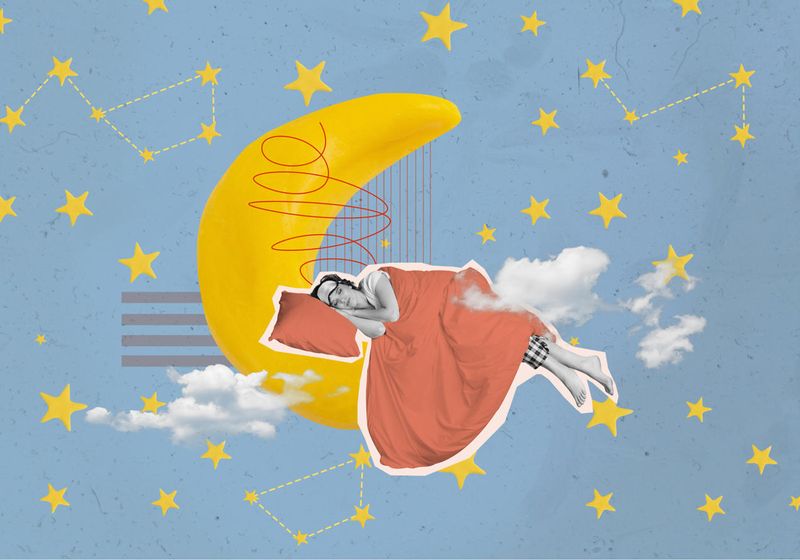Brain activity, cellular architecture, and personality traits influence people’s dream recall capability.
Imagine standing in a quiet meadow; the emerald grass blades and yellow flowers sway with a gentle breeze. As a brook murmurs in the distance, everything feels weightless and soft. Then, with a sharp ring of an alarm, the dream is over and forgotten, each tiny detail slipping away as time passes.
Despite experiencing realistic and vivid dreams, many people forget them as soon as they wake up. While women tend to remember more of their dreams compared to men, many other aspects dictate dream recall ability as well.1
Caroline Horton studies sleep and cognition at Bishop Grosseteste University.
Bishop Grosseteste University
“The different factors will relate to how long we’ve been asleep for, how quickly we are transitioning from sleep to wake, how much time we have spent in [a particular] sleep [stage],” said Caroline Horton, a sleep and cognition researcher at Bishop Grosseteste University. Aside from this, neurotransmitter levels and brain activity during sleep, brain architecture, and personality traits influence how likely a person is to remember their dreams.
Studying Dreams and Dream Recall
Dreaming is an almost universal experience, yet researchers don’t fully understand the process or why it happens. While some scientists believe that dreaming reflects emotional regulation and processing, others have shown that people who do not remember their dreams show no impairment compared to those who do.2,3
“Obviously that implies then that dreaming maybe doesn’t really have a function,” said Horton. “My view is that when we sleep, we dream and we process our emotions, but I don’t think we necessarily need to remember those dreams in order to benefit from them.”
To understand dreams and dream recall, Horton and her team routinely recruit volunteers who participate in sleep studies from the comfort of their homes rather than in sleep labs. “People dream about things that are novel, and if they’re sleeping differently, which they always are in a lab compared to home, then they don’t quite switch off,” explained Horton.
The researchers use portable sleep polysomnography devices to track the participants’ various sleep stages, and alarms wake them up at different times through the night. The participants then record what was going through their mind when they were woken up.
According to Horton, while about 70 percent of the people can remember their dreams, the extent to which each person can recall the details varies. This recall ability also changes based on which sleep stage the participants wake up from.
Sleep Stages and Dream Recall Frequency
People usually experience four stages of sleep with distinct brain activities—one rapid eye movement (REM) stage and three non-REM (NREM) ones—which cycle every 80 to 100 minutes. The transition from wakefulness to sleep takes people through NREM 1 stage. As they fall asleep and slip into deep sleep, their brain activity slows down, which make up NREM 2 and NREM 3 stages. Finally, during REM sleep, people show similar brain activity as during wakefulness.
Although the most vivid, realistic, and longest dreams occur during the REM stage, people dream during all sleep stages.4 Dream recall frequency, however, differs between each stage: Up to 90 percent and 50 percent of people remember their dreams when woken up from REM and NREM 3 stages, respectively.5 “So, it’s not as clear cut as saying we dream during rapid eye movement sleep, and this is what the brain is doing at the time,” said Horton. “The brain is changing all the time, and our ability to remember a dream or not is changing all the time.”
Molecular, Electrophysiological, and Psychological Aspects of Dream Recall
To better understand why dream recall varies between REM and NREM sleep, researchers dissected the biochemical differences during these stages. They observed a spike in acetylcholine levels during REM sleep, leading them to link the neurotransmitter to dream recall frequency.6
Studying people with varied dream recall frequencies has also provided some clues. People who remembered their dreams more often showed increased activity in brain regions crucial for dreaming.7 To determine whether anatomical features underlie these physiological differences, researchers studied the cellular architecture of brain regions related to dream recall. They observed a greater density of white matter—the central nervous system tissue that is mainly made up of myelinated axon—in people who could recall more of their dreams.8
Zooming out from the cellular and molecular aspects, researchers have also found a link between personality traits and dream recall frequency. For instance, studying more than 2,000 people revealed that those with a positive attitude toward dreaming and openness to experiences recalled dreams more frequently.9 Horton found that those who can elaborate more on details and have a higher fantasy-prone personality are more likely to recall their dreams.10
To her, this makes sense. “Dream recall is about an imaginative process where you might fill in the blanks, rather than actually dreaming differently,” said Horton. “The differences are around the construction of the memory of the dream, rather than probably the nature of the dream in the first place.”
Ultimately, researchers still do not fully understand why people forget so many of their dreams. This is, in part, due to the challenges of researching sleep and dreams. Aside from the logistics of conducting experiments, researchers have to rely on people’s memory as they self-report their dreams. “It’s [difficult to] try to disentangle the original dream memory from a narrative that somebody’s wanting to tell you with their waking cognitive head on,” said Horton. She hopes that advances in sleep technology will help unravel the mysteries and answer long-standing questions in the field.
- Brand S, et al. Dream recall and its relationship to sleep, perceived stress, and creativity among adolescents. J Adolesc Health. 2011;49(5):525-531.
- Scarpelli S, et al. The functional role of dreaming in emotional processes. Front Psychol. 2019;10:459.
- van Wyk M, et al. Increased awakenings from non-rapid eye movement sleep explain differences in dream recall frequency in healthy individuals. Front Hum Neurosci. 2019;13:370.
- Horton CL. Key concepts in dream research: Cognition and consciousness are inherently linked, but do not control “control”! Front Hum Neurosci. 2020;14:259.
- Malinowski JE, Horton CL. Dreams reflect nocturnal cognitive processes: Early-night dreams are more continuous with waking life, and late-night dreams are more emotional and hyperassociative. Conscious Cogn. 2021;88:103071.
- Becchetti A, Amadeo A. Why we forget our dreams: Acetylcholine and norepinephrine in wakefulness and REM sleep. Behav Brain Sci. 2016;39:e202.
- Eichenlaub JB, et al. Resting brain activity varies with dream recall frequency between subjects. Neuropsychopharmacology. 2014;39(7):1594-1602.
- Vallat R, et al. Dream recall frequency is associated with medial prefrontal cortex white-matter density. Front Psychol. 2018;9:1856.
- Schredl M, Göritz AS. Dream recall frequency, attitude toward dreams, and the Big Five personality factors. Dreaming. 2017;27(1):49–58.
- Horton CL. Correlates of dream recall: Implications for confabulation. Imagin.Cogn. Pers. 2014;34(2):163-177.




